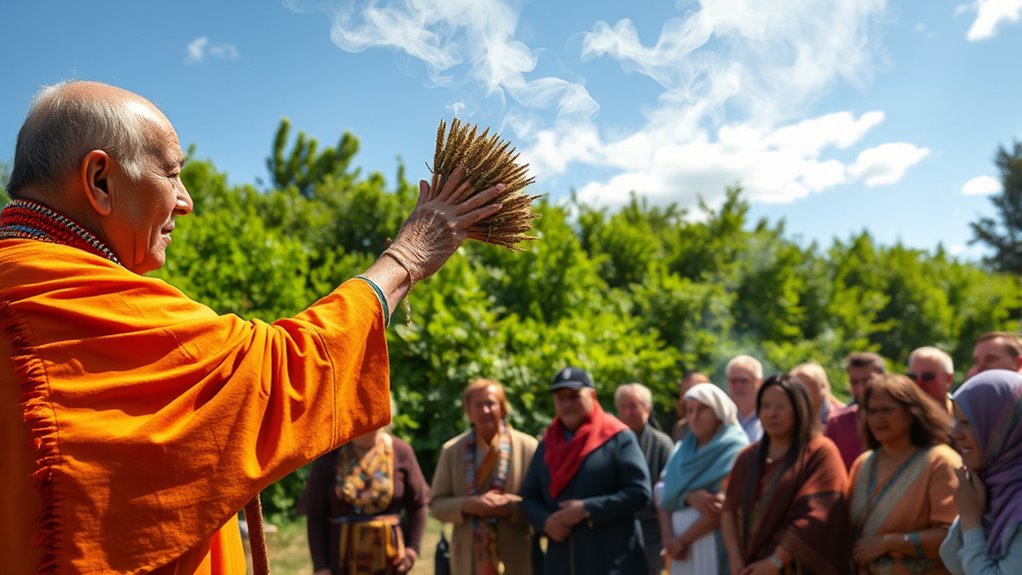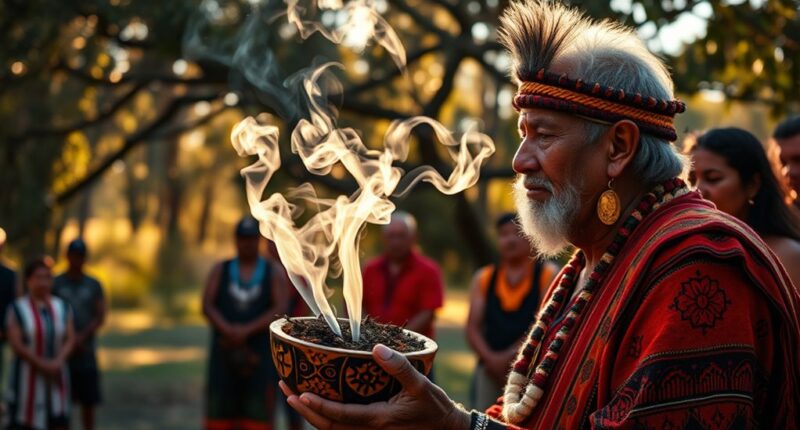To participate in a smoking ceremony, you must first seek permission from community elders or custodians. Wait for their invitation and follow their guidance carefully. Respect the cultural significance by listening attentively, supporting the ritual without interfering, and avoiding photos unless allowed. Remember, these ceremonies are sacred and rooted in tradition. Approaching with humility and understanding helps uphold their importance. Keep exploring to learn more about honoring these authentic cultural practices.
Key Takeaways
- Wait for permission from community elders before participating in the ceremony.
- Follow the guidance of the host or elder and listen carefully during the ritual.
- Support the ceremony by supporting traditional steps like wafting smoke respectfully.
- Avoid taking photos or intruding unless explicitly allowed by the community.
- Approach with humility, understanding the spiritual significance and cultural importance of the ceremony.

Have you ever wondered why respecting cultural protocols matters when engaging with different communities? It’s because these protocols serve as a bridge to authentic connections and demonstrate genuine respect for indigenous traditions. When you participate in or observe practices like a smoking ceremony, understanding the significance behind it is essential for respectful engagement. These ceremonies are deeply rooted in indigenous cultures, often symbolizing cleansing, renewal, and the welcoming of spirits or guests. Recognizing their importance helps you honor the community’s history and beliefs, showing that you value their traditions rather than just observing them superficially.
Timing is fundamental when performing a smoking ceremony. Typically, you wait for an invitation or permission from community elders or cultural custodians before participating. This step isn’t just politeness; it’s a recognition that such ceremonies are sacred and should be approached with humility and understanding. Engaging at the wrong time or without proper authorization can be seen as disrespectful and may undermine the ceremony’s purpose. When invited, you should approach the ritual with an open mind and a respectful attitude, understanding that it’s more than a cultural display—it’s a spiritual act that connects people to land, ancestors, and community. Additionally, understanding the cultural significance of the ceremony enhances your respectful participation.
Knowing how to perform or participate in a smoking ceremony involves following specific protocols. Usually, the host or elder will guide you through the process, explaining its significance and what is expected. It’s important to listen carefully, ask respectful questions if appropriate, and follow their lead. You might be asked to hold or waft the smoke towards yourself or others, symbolizing the cleansing of negative energies. Maintaining a respectful demeanor, avoiding intrusive behavior, and refraining from taking photos without permission are key to showing reverence. Your role isn’t to lead or modify the ritual but to support and honor its traditional form.
In essence, understanding when and how to perform a smoking ceremony demonstrates respectful engagement with indigenous traditions. It’s about acknowledging the cultural significance, following the guidance of community elders, and approaching the ritual with humility. Doing so fosters trust and demonstrates your genuine respect for the community’s sacred practices. Remember, these ceremonies aren’t just cultural performances—they are crucial expressions of identity and spirituality. By respecting these protocols, you help preserve their integrity and ensure meaningful, respectful interactions with indigenous communities.
Frequently Asked Questions
Can Non-Indigenous People Participate in Smoking Ceremonies?
You can participate in smoking ceremonies, but it is crucial to do so respectfully to avoid cultural appropriation. Always seek permission from Indigenous elders or community members before joining, and follow their guidance closely. Your respectful participation shows appreciation and understanding of their traditions. Avoid taking photos or sharing details without consent, and remember, the ceremony’s significance is deeply spiritual, so approach it with humility and genuine respect.
Are There Specific Times of Day for Performing a Smoking Ceremony?
You can perform a smoking ceremony at any time of day, as it often aligns with daily rituals or specific cultural practices. Many find dawn or dusk meaningful, symbolizing new beginnings or reflection. The timing depends on the purpose, community tradition, or personal intention behind the ceremony. Being mindful of ceremony timings respects its significance, helping you connect deeply with the ritual’s spiritual symbolism and honoring its cultural roots.
How Do I Respectfully Approach Indigenous Elders for Guidance?
You should approach indigenous elders with cultural sensitivity and respectful communication. Start by expressing your genuine interest and ask if they’re willing to share guidance. Be humble, listen carefully, and follow their lead. Remember, building trust takes time, so show respect for their traditions and boundaries. By demonstrating your sincerity and understanding, you create a respectful connection that honors their cultural protocols.
What Are the Typical Materials Used in a Smoking Ceremony?
You typically use ceremonial herbs like native eucalyptus, white sage, or native bush herbs to create sacred smoke during a smoking ceremony. You light these herbs carefully, allowing the smoke to waft around the space or person involved. Always respect the materials and the cultural significance behind them. Remember, the herbs symbolize purification, so handle them with reverence and intention, honoring the tradition and its spiritual importance.
Are There Any Restrictions or Sensitivities to Consider During Ceremonies?
While respecting sacred spaces, you should always be mindful of cultural sensitivities during ceremonies. Avoid taking photos without permission, and speak softly to honor the spiritual significance. Be cautious of specific restrictions, such as not touching certain objects or entering particular areas. By approaching with reverence and awareness, you guarantee the ceremony remains respectful and meaningful, honoring the traditions and beliefs of those involved.
Conclusion
Understanding when and how to perform a smoking ceremony is like steering a delicate dance—respectful, intentional, and grounded in tradition. By following cultural protocols, you honor the sacred roots of this practice and guarantee it remains a meaningful gesture. When performed with genuine respect, it’s as if you’re tending to a precious flame, guiding it with care and reverence. Embrace these protocols, and you’ll keep the spirit of the ceremony alive, glowing brightly for generations to come.









